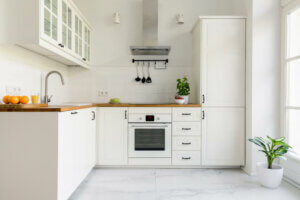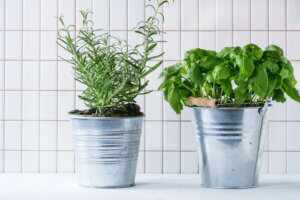How to Design a Sustainable Kitchen

When it comes to making our time on the planet more ecological, designing a sustainable kitchen can play an important part. In a world that’s dominated by consumerism, your home could be a very eco-friendly place.
Generally speaking, people are becoming more respectful towards the environment, including in their choice of sustainable kitchen designs. It’s very important to do your bit by designing an eco-friendly home.
You could start by making some simple, practical changes to your kitchen. Why not start by using utensils made of sustainable materials, and then maybe move on to separating out or recycling some of your trash?
Changing your daily habits could also have a positive impact. Using more sustainable materials in your kitchen furniture or buying electrical appliances that are more energy efficient would be ways to make your kitchen “greener”.
If you’re not sure where to start, or how to design a more sustainable kitchen, here are a couple of ideas that will give you great results.
Furniture for a sustainable kitchen

Using natural materials for your kitchen units or kitchen furniture is an excellent way of making your kitchen sustainable. It’s also a good idea to use materials, such as wood, that have chain-of-custody certification from the FSC.
FSC (Forest Stewardship Council) certification guarantees that the wood used is sourced entirely from sustainable forests.
Another great idea is to reuse furniture that you’ve stored away and don’t use. By restoring old pieces of furniture like this, you would be giving them a new life, while also giving your kitchen a vintage and rustic look.
Sustainable lighting with LEDs

It’s our social responsibility to improve our homes to make them more sustainable. Using LED lighting could be one of those improvements. This type of lighting can have a very positive effect on the environment, given that it is much more eco-friendly than normal lighting.
Bulbs and lamps are normally made with metals and gases that pollute the environment. These can also be dangerous to humans, and so safely disposing of bulbs and lamps can be a real challenge.
Using LED lighting can protect not only your health but also the environment. This lighting is best used on work spaces, where you could use LED reflectors or spotlights to focus the light on your worktops or cooktop.
However, let’s not forget that kitchens are a place for enjoyment, and LED lighting can be decorative. For example, you could install LEDs in your cutlery drawers to give them a more sophisticated look.
Forget incandescent lighting and opt for a more sustainable alternative, such as LED lighting.
Choose efficient domestic appliances for your sustainable kitchen

According to some consumer studies, up to 68% of energy waste in US homes comes from domestic appliances. It’s important to bear in mind that cheap domestic appliances could be causing your energy bills to rocket.
The figures suggest that more energy-efficient appliances use up to three times less energy than those that aren’t energy-efficient. It’s therefore strongly advised that you use domestic appliances that are more energy-efficient.
Efficient domestic appliances may have a higher price tag, but they are an investment that keeps giving year after year. They not only save energy and reduce electricity and water bills, but they also last much longer. By choosing a more efficient domestic appliance, you’ll reduce your kitchen’s impact on the environment.
Never place your refrigerator next to other appliances

It’s important to remember that your kitchen’s layout will not only determine it’s overall design, but it can also impact your spending on electricity.
It’s best not to place your refrigerator next to your microwave or oven, as it’ll need to work harder to keep cool. If you place your refrigerator further away, then it’ll be able to maintain its temperature more easily.
How can you make your kitchen more sustainable? Only use the water you need

One of the best ways to avoid wasting water is to not leave it running. If you’re washing fruit or vegetables, it’s a good idea to fill your sink with water and wash them all at once.
Another good way of saving water is to not leave the water running while you wash up. When it comes to washing your plates and glasses, you can lather then up in one sink, and then wash them clean in the other.
Always try to fill the dishwasher completely before putting it on. Remember that your dishwasher will use the same amount of water whether it’s half full or completely full.
You could also install aerators to reduce the volume of water that flows from your faucets. Aerators help you control the amount of water you use, which will not only benefit the environment but also help reduce your water bill.
Grow a kitchen garden

There’s nothing quite like the smell of fresh basil or freshly cut parsley. You don’t need a huge house to grow your own garden, even a small apartment is enough. Nor do you actually need a garden or a balcony, your kitchen is the perfect spot.
All you’ll need to grow your own kitchen garden is a wall that gets a lot of sun. Seedlings need very little space and don’t take long to grow, so they’re a good option. Growing your own garden will help you maintain both a healthy and natural diet.
You could also make the most of your kitchen’s space, for example by hanging flowerpots from your ceiling. Another idea is to recycle plastic bottles and sow seeds in them or sow plants that will help your family lead a healthy lifestyle.
The environment is currently under constant threat. If you’ve always wondered how you can create a sustainable kitchen, then these ideas will help you to help the planet.
When it comes to making our time on the planet more ecological, designing a sustainable kitchen can play an important part. In a world that’s dominated by consumerism, your home could be a very eco-friendly place.
Generally speaking, people are becoming more respectful towards the environment, including in their choice of sustainable kitchen designs. It’s very important to do your bit by designing an eco-friendly home.
You could start by making some simple, practical changes to your kitchen. Why not start by using utensils made of sustainable materials, and then maybe move on to separating out or recycling some of your trash?
Changing your daily habits could also have a positive impact. Using more sustainable materials in your kitchen furniture or buying electrical appliances that are more energy efficient would be ways to make your kitchen “greener”.
If you’re not sure where to start, or how to design a more sustainable kitchen, here are a couple of ideas that will give you great results.
Furniture for a sustainable kitchen

Using natural materials for your kitchen units or kitchen furniture is an excellent way of making your kitchen sustainable. It’s also a good idea to use materials, such as wood, that have chain-of-custody certification from the FSC.
FSC (Forest Stewardship Council) certification guarantees that the wood used is sourced entirely from sustainable forests.
Another great idea is to reuse furniture that you’ve stored away and don’t use. By restoring old pieces of furniture like this, you would be giving them a new life, while also giving your kitchen a vintage and rustic look.
Sustainable lighting with LEDs

It’s our social responsibility to improve our homes to make them more sustainable. Using LED lighting could be one of those improvements. This type of lighting can have a very positive effect on the environment, given that it is much more eco-friendly than normal lighting.
Bulbs and lamps are normally made with metals and gases that pollute the environment. These can also be dangerous to humans, and so safely disposing of bulbs and lamps can be a real challenge.
Using LED lighting can protect not only your health but also the environment. This lighting is best used on work spaces, where you could use LED reflectors or spotlights to focus the light on your worktops or cooktop.
However, let’s not forget that kitchens are a place for enjoyment, and LED lighting can be decorative. For example, you could install LEDs in your cutlery drawers to give them a more sophisticated look.
Forget incandescent lighting and opt for a more sustainable alternative, such as LED lighting.
Choose efficient domestic appliances for your sustainable kitchen

According to some consumer studies, up to 68% of energy waste in US homes comes from domestic appliances. It’s important to bear in mind that cheap domestic appliances could be causing your energy bills to rocket.
The figures suggest that more energy-efficient appliances use up to three times less energy than those that aren’t energy-efficient. It’s therefore strongly advised that you use domestic appliances that are more energy-efficient.
Efficient domestic appliances may have a higher price tag, but they are an investment that keeps giving year after year. They not only save energy and reduce electricity and water bills, but they also last much longer. By choosing a more efficient domestic appliance, you’ll reduce your kitchen’s impact on the environment.
Never place your refrigerator next to other appliances

It’s important to remember that your kitchen’s layout will not only determine it’s overall design, but it can also impact your spending on electricity.
It’s best not to place your refrigerator next to your microwave or oven, as it’ll need to work harder to keep cool. If you place your refrigerator further away, then it’ll be able to maintain its temperature more easily.
How can you make your kitchen more sustainable? Only use the water you need

One of the best ways to avoid wasting water is to not leave it running. If you’re washing fruit or vegetables, it’s a good idea to fill your sink with water and wash them all at once.
Another good way of saving water is to not leave the water running while you wash up. When it comes to washing your plates and glasses, you can lather then up in one sink, and then wash them clean in the other.
Always try to fill the dishwasher completely before putting it on. Remember that your dishwasher will use the same amount of water whether it’s half full or completely full.
You could also install aerators to reduce the volume of water that flows from your faucets. Aerators help you control the amount of water you use, which will not only benefit the environment but also help reduce your water bill.
Grow a kitchen garden

There’s nothing quite like the smell of fresh basil or freshly cut parsley. You don’t need a huge house to grow your own garden, even a small apartment is enough. Nor do you actually need a garden or a balcony, your kitchen is the perfect spot.
All you’ll need to grow your own kitchen garden is a wall that gets a lot of sun. Seedlings need very little space and don’t take long to grow, so they’re a good option. Growing your own garden will help you maintain both a healthy and natural diet.
You could also make the most of your kitchen’s space, for example by hanging flowerpots from your ceiling. Another idea is to recycle plastic bottles and sow seeds in them or sow plants that will help your family lead a healthy lifestyle.
The environment is currently under constant threat. If you’ve always wondered how you can create a sustainable kitchen, then these ideas will help you to help the planet.







